1. Introduction
.jpg) Nvidia recently announced a new series of VGA cards, the Nvidia 7950GT series, mainly aimed at enthusiast users who want maximum performance and visual quality. We had the chance to test three 7950GT cards, with different cooling system designs and clock speeds. So which is the fastest 7950GT card you can buy nowadays?
Nvidia recently announced a new series of VGA cards, the Nvidia 7950GT series, mainly aimed at enthusiast users who want maximum performance and visual quality. We had the chance to test three 7950GT cards, with different cooling system designs and clock speeds. So which is the fastest 7950GT card you can buy nowadays?
- Geforce 7950GT series
High memory interface and fast GDDR3 memory enable blazing graphics performance with the quality set to max so you don’t have to choose between frame rates and image quality. Need a break from gaming? The GeForce 7950 GPU delivers smooth, high-definition video playback and crisp picture quality, thanks to its advanced NVIDIA PureVideo technology. If you are searching for an extreme HD gaming and video experience on the PC, look no further than the GeForce 7950 GPU.

128-bit Studio-Precision Computation
128-bit studio-precision computation through the entire pipeline prevents image defects due to low precision and ensures the best image quality for even the most demanding applications.
256-bit Memory Interface
Delivers more memory bandwidth and efficiency to power the latest games and applications at blazing speeds.
Adaptable Programmable Video Processor
PureVideo's programmable technology adapts to new video encoding formats as they are developed to provide a future-proof video solution. (Feature requires supported video software.)
Advanced Spatial Temporal De-interlacing
Smoothes video and DVD playback on progressive displays to deliver a crisp, clear picture that rivals high-end home theater systems.
Dual 400MHz RAMDACs
Blazing-fast RAMDACs support dual QXGA displays with ultra-high, ergonomic refresh rates--up to 2048x1536@85Hz.
Dual DVI Support
Able to drive the industry's largest and highest resolution flat-panel displays.
High-Speed GDDR3 Memory Interface
Support for the world's fastest GDDR3 memory delivers fluid frame rates for even the most advanced games and applications.
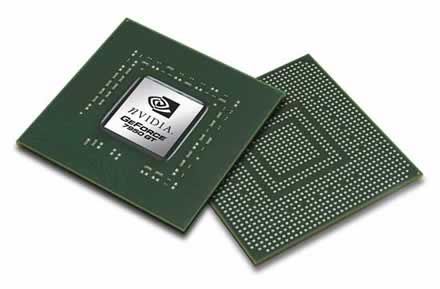
Integrated HDTV Encoder
Provides world-class TV-out functionality up to 1080i resolution.
Microsoft® DirectX® 9.0 Shader Model 3.0 Support
Ensures top-notch compatibility and performance for all DirectX® 9 applications, including Shader Model 3.0 titles.
Next-generation Superscalar GPU Architecture
Delivers up to 2x the shading power of previous generation products taking gaming performance to extreme levels.
NVIDIA® CineFX™ 4.0 Engine
Delivers advanced visual effects at unimaginable speeds. Full support for Microsoft® DirectX® 9.0 Shader Model 3.0 enables stunning and complex special effects. Next-generation shader architecture with new texture unit design streamlines texture processing for faster and smoother gameplay.
NVIDIA® Digital Vibrance Control™ (DVC) 3.0 Technology
Allows the user to adjust color controls digitally to compensate for the lighting conditions of their workspace, in order to achieve accurate, bright colors in all conditions.
NVIDIA® Intellisample™ 4.0 Technology
The industry's fastest antialiasing delivers ultra-realistic visuals, with no jagged edges, at lightning-fast speeds. Visual quality is taken to new heights through a new rotated grid sampling pattern, advanced 128 Tap sample coverage, 16x anisotropic filtering, and support for transparent supersampling and multisampling.
NVIDIA® PureVideo™ Technology
The combination of high-definition video processors and NVIDIA DVD decoder software delivers unprecedented picture clarity, smooth video, accurate color, and precise image scaling for all video content to turn your PC into a high-end home theater. (Feature requires supported video software.)
NVIDIA® UltraShadow™ II Technology
Enhances the performance of bleeding-edge games, like id Software's Doom 3, that feature complex scenes with multiple light sources and objects.
nView™ Multi-Display Technology
The nView hardware and software technology combination delivers maximum flexibility for multi-display options, and provides unprecedented end-user control of the desktop experience.
OpenGL™ 2.0 Optimizations and Support
Ensures top-notch compatibility and performance for all OpenGL applications. NVIDIA® nView® Multi-display Advanced technology provides the ultimate in viewing flexibility and control for multiple monitors.
PCI Express™ Support
Designed to run perfectly with the next-generation PCI Express bus architecture. This new bus doubles the bandwidth of AGP 8X delivering over 4 GB/sec. in both upstream and downstream data transfers.
Video Color Correction
Color temperature correction makes actors' faces appear natural, rather than washed out and pale, when playing videos on LCD and CRT displays. Display gamma correction ensures videos are not too dark, overly bright, or washed out regardless of the video format or display. (Feature requires supported video software.)
90nm Process Technology
Delivers higher performance through blazing clock rates.
Built for Microsoft® Windows Vista™
NVIDIA's third-generation GPU architecture built for Windows Vista give users the best possible experience with the 3D graphical user interface in the upcoming operation system (OS) from Microsoft.
High-Definition H.264, MPEG-2 and WMV Hardware Acceleration2
Smoothly playback H.264, MPEG-2, and WMV video—including WMV HD—with minimal CPU usage so the PC is free to do other work.
 NVIDIA® SLI™ Technology
NVIDIA® SLI™ Technology
Delivers up to 2x the performance of a single GPU configuration for unparalleled gaming experiences by allowing two graphics cards to run in parallel. The must-have feature for performance PCI Express graphics, SLI dramatically scales performance on over 60 top PC games.
GeForce 7 Series GPUs Model Comparison
Feature |
GeForce 7950 Models |
GeForce 7900 Models |
GeForce 7800 Models |
GeForce 7600 Models |
GeForce 7300 Models |
Graphics Bus Technology |
PCI Express |
PCI Express |
AGP 8X/PCI Express |
AGP 8X/PCI Express |
PCI Express |
Microsoft® DirectX® 9.0 |
SM3.0 |
SM3.0 |
SM3.0 |
SM3.0 |
SM3.0 |
NVIDIA® Intellisample™ Technology |
4.0 |
4.0 |
4.0 |
4.0 |
4.0 |
NVIDIA® SLI™ Technology |
Y |
Y |
Y |
Y |
Y |
High Dynamic-Range (HDR) Support |
Y |
Y |
Y |
Y |
Y |
NVIDIA® TurboCache™ Technology |
n/a |
n/a |
n/a |
n/a |
Y |
Effective Memory Interface |
512-bit |
256-bit |
256-bit |
128-bit |
128-bit3/64-bit |
Memory |
GDDR3 |
GDDR3 |
GDDR3 |
GDDR3/DDR2 |
GDDR3/DDR2 |
Process |
0.09 µ |
0.09 µ |
0.11 µ |
0.09 µ |
0.09 µ |
RAMDACs |
400MHz |
400MHz |
400MHz |
400MHz |
400MHz |
Before buying such high end cards, you should be aware of the system requirements:
1. Microsoft Windows® 2000/XP
2. A PCI-Express compliant motherboard with full size expansion slot
3. Installation requires CD-ROM or DVD-Rom drive
4. A 6-pin PCI Express supplementary power connector
5. DVI or VGA compatible monitor
6. Minimum of 500-600W Power Supply with a minimum of +12V @ 30A for all PC components in SLI mode
2. XFX GeForce 7950GT 550M

XFX has a long tradition of producing unique products based on Nvidia chipsets. The GeForce 7900 series, offers full DirectX 9.0 Shader Model 3.0 Support and other impressive features.

Currently, XFX has five variations of the 7950GT series, with different core/memory clocks, cooling system and features:
Model |
Core |
Memory |
Other features |
Cooling system |
PV-T71J-YHD9 |
610 MHz |
1.6 GHz |
TV Capture |
Air |
PV-T71J-YHE9 |
570 MHz |
1.5 GHz |
TV Out |
Passive |
PV-T71J-YPE7 |
570 MHz |
1.46 GHz |
- |
Air |
PV-T71J-YHF9 |
550 MHz |
1.4 GHz |
TV Out |
Passive |
PV-T71J-YPF7 |
550 MHz |
1.4 GHz |
- |
Air |
The fastest XFX 7950GT card you can buy, comes with 610MHz/1.6GHz clock speeds. For our tests, XFX provided us with the "PV-T71J-YHF9" model, with 550MHz core and 1.4GHz memory clocks. The card can be found online at the retail price of €270~300. The retail box has the usual impressive XFX design:
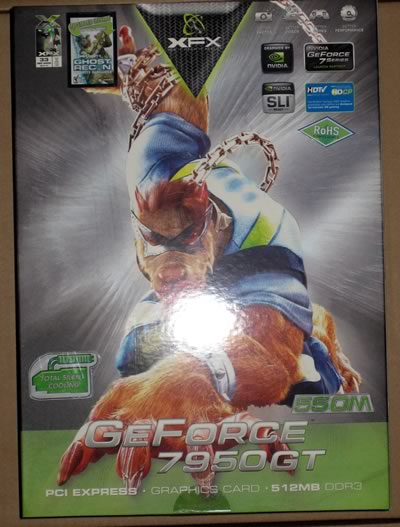
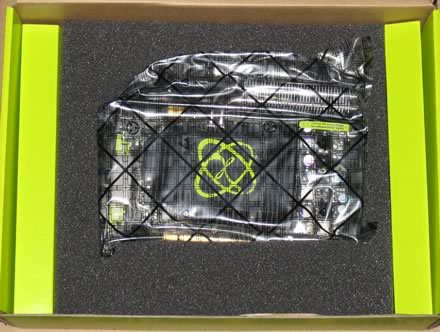
XFX has included with the card, the retail version of Ghost Recon Advanced Warfighter!
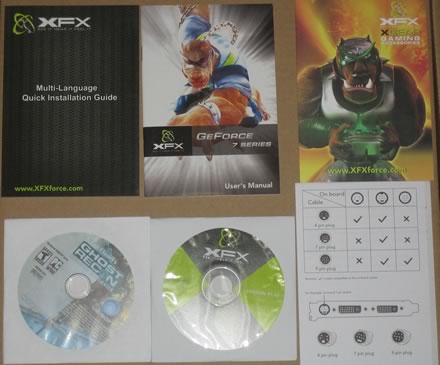

While all required cables and connectors are also included:
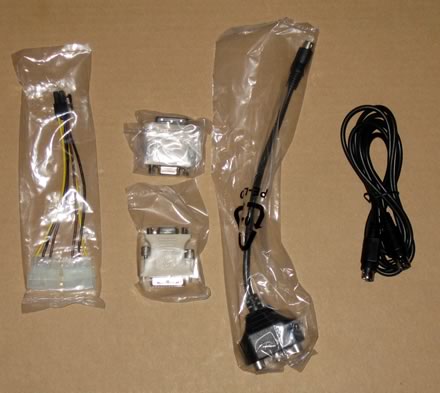
To sum it up, the retail package includes:
- A 7950GT card
- A printed user's manual in 13 languages
- A printed quick installation guide
- 2x DVI-D Sub15 Dongles
- A S-Video to Composite Cable
- Software CD with drivers
- Retail version of Ghost Recon Advanced WarFighter
Looking at the card, its a mid sized, so will fit without too many problems in a mid ATX box. Despite using passive cooling, the overall size/weight ratio is good.
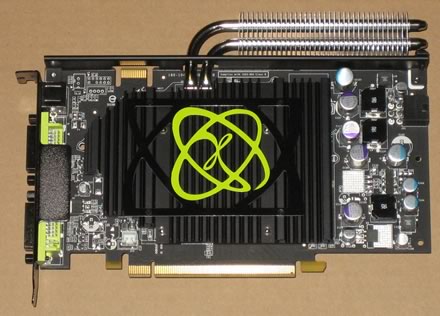
The card needs a PCI-E power supply in order to operate. Remember, you need at least a 600W SLI certified PSU if you decide to go SLI.

The card has two DVI-D outputs and one S-Video output.
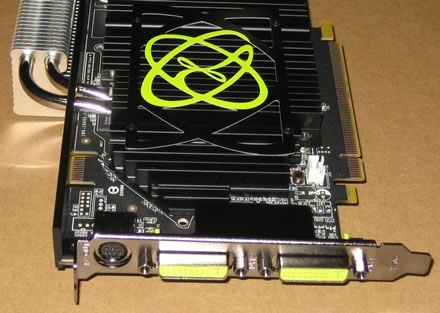
On the back of the card, we can see the passive cooling solution's aluminium fins.
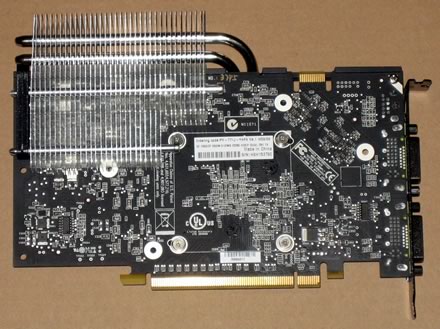

The memory is clocked at 770MHz, while the GPU at 550MHz. The XFX 7950GT uses Infineon 1.4ns DDR3 memory modules (HYB18H512321BF-14), providing a total memory size of 512MB RAM. The G71GT core is shown below.
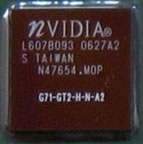
Everest Ultimate Edition 2006 gives us some more information about the G71GT core.

3. Gainward BLISS 7950GT 512MB Golden Sample

Gainward presents its proposal for the 7950GT platform. The NVIDIA® SLI™-Ready GeForce® 7950 GT graphics processing units (GPU´s) cranks up the graphics horsepower with a whopping 512MB memory and 550MHZ core. Power through games with exceptionally smooth frame rates in widescreen resolutions up to 2560x1600, and enjoy ultra fluid, high-definition video playback using advanced NVIDIA® PureVideo™ HD technology. More is better.
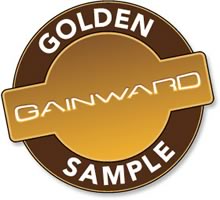 The BLISS 7950GT 512MB comes with the logo "Golden Sample", indicating improved core/memory clocks over other manufacturers
The BLISS 7950GT 512MB comes with the logo "Golden Sample", indicating improved core/memory clocks over other manufacturers
"...Golden Sample products from Gainward offer a higher clock setting than reference-design boards. That is the heart and soul of Gainward's Golden Sample. With some products this is achieved by using higher performing components than on the reference design boards and on other products the higher performance is achieved by using software utilities..."
Currently, Gainward has three variations of the 7950GT series, with different core/memory clocks and memory size:
Model |
Core |
Memory |
Other features |
8101-BLISS 7950GT 512MB TV DD |
550 MHz |
1.4 GHz |
1,4ns DDR-3 |
8149-BLISS 7950GT 512MB Golden Sample |
580 MHz |
1.5 GHz |
1,2ns DDR3 |
8187-BLISS 7950GT 256MB Golden Sample |
580 MHz |
1.5 GHz |
1,2ns DDR-3 |
The fastest Gainward 7950GT card you can buy comes with 580MHz/1.5GHz clock speeds. For our tests, Gainward provided us with the "8149-BLISS 7950GT 512MB Golden Sample" model. The card can be found online at the retail price of €285~320. The retail box has a unique design and includes the "Golden Sample" logo:

The retail package is complete with printed manual, drivers and of course, cables:

To sum it up, the retail package includes:
- A 7950GT card
- A printed start manual (available in
English/French/German/Italian)
- A warranty card with printed #SN (you can download free games from Gainward)
- 2x DVI-D to VGA converters
- A power to PCI-E cable
- A TV-out cable (HDTV support)
- Software CD with drivers
- Retail version of Muvee AutoProducer
Looking at the card, it is mid-sized, so will fit without many problems in an ATX box. It will occupy two of your free slots, due to its air cooling system. If you look carefully, you will see that the copper profile also covers the memory chips and improves overclocking capabilities.

The card needs a PCI-E power supply in order to operate. You need at least a 600W SLI certified PSU if you decide to go SLI.
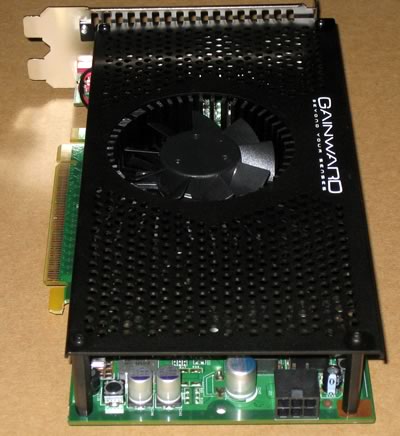
The card has two DVI-D outputs and one TV-out output. The second free backport slot is used to exhaust any hot air generated by the card:
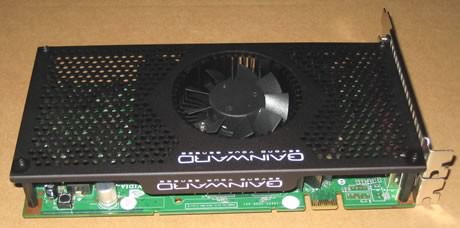
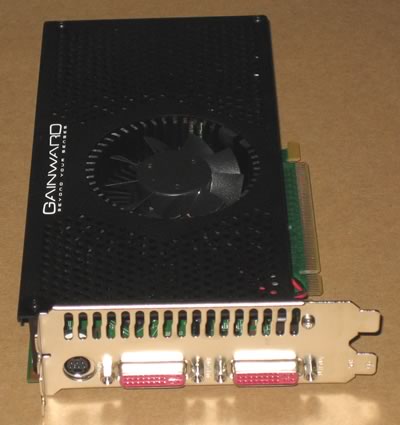
On the back, we can see the board design and a big metal plate that secures the whole air cooling system in place.
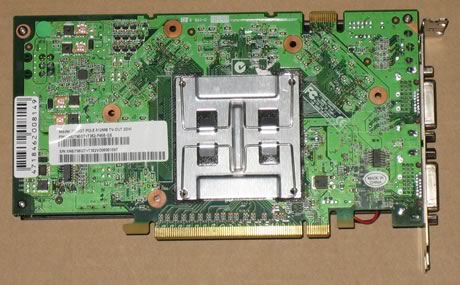
The memory is clocked at 750MHz, while the GPU at 580MHz. The Gainward 7950GT uses Samsung 1.2ns memory modules (DDR3), providing a total memory size of 512MB RAM. Hopefully, due to its cooling design, it would be a great overclocker. We will examine this later in our review.
4. eVGA e-GeForce 7950GT KO
eVGA has its own 7950GT card, carefully "boosted" up to 600MHz, as the sticker on the retail package indicates. Currently, eVGA has three variations of the 7950GT series, with different core and memory clocks:
Model |
Core |
Memory |
Model Number |
e-GeForce 7950 GT Superclocked 512MB |
600 MHz |
1.45 GHz |
512-P2-E637-AR |
e-GeForce 7950 GT KO 512MB |
560 MHz |
1.45 GHz |
512-P2-E635-AR |
e-GeForce 7950GT |
550 MHz |
1.40 GHz |
512-P2-E633-AR |
The fastest eVGA 7950GT card you can buy comes with 600MHz/1.45GHz clock speeds. For our tests, eVGA provided us with the "e-GeForce 7950 GT Superclocked 512MB" model. The card can be found at online stores, for the retail price of €290~310. The retail box is rather typical and includes a lot of information, including support for the latest standards.


The retail package is complete with printed manual, drivers and of course cables:


To sum it up, the retail package includes:
- A 7950GT card
- A printed user's guide
- 2x EVGA case stickers
- 2x DVI-D to VGA converters
- A 6 pin PCI-E power cable
- A S-Video cable (HDTV support)
- Software CD with drivers
- Retail version "Call Of Duty 2"
Looking at the card, it is mid-sized, and will fit without many problems in your mid-ATX box. It uses a normal sized air cooling system with copper heatsink. If you look carefully, you will see that the copper profile covers the memory chips, helping improve overclocking capabilities.

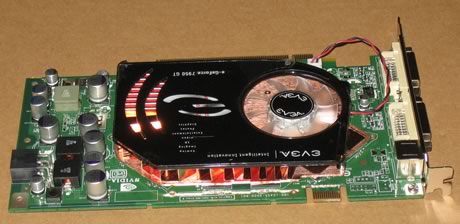
The card needs a PCI-E power supply in order to operate. You need at least a 600W SLI certified PSU if you decide to go SLI.

The card has two DVI-D outputs and one TV-out output.

On the back, we can see the board is free of any cooling fins or plates that we saw with the previous cards. Instead, four screws keep the cooling system in place.

The memory is clocked at 725MHz, while the GPU at 600MHz. The eVGA 7950GT uses Infineon 1.4ns DDR3 memory modules ( HYB18H512321BF-14), providing a total memory size of 512MB RAM.
5. Tests and setup
All tests were conducted with the same PC setup:
- Asus M2N32 WS Pro Bios 601 (Nvidia 590SLI) + AMD Athlon X2 4600+
- Thermaltake Soprano Case
- OCZ GameXStream GXS600 SLI-Ready
- 2x1GB Crucial PC2-8000 @ 4-4-4-8-2T
- WD 800JB 7200RPM
- Viewsonic 19" LCD VP930b (1280x1024 resolution)
- Windows XP SP2 with all latest updates installed
- Nvidia Forceware v93.71 with the following settings

We used a variety of games and applications to evaluate each VGA card's performance:
- FRAPS v2.8.0
- 3D Mark 05 v1.2.0
- 3D Mark 06 v1.2.0
- F.E.A.R v1.08
- Prey v1.2.0
- Half Life 2 Episode 1 June Edition
- Splinter Cell - Chaos Theory v1.05
- Battlefield 2142 v1.00
- Company Of Heroes v1.3.0
- Neverwinter Nights 2 v1.00
- NFS Carbon v1.2.0
6. 3D Mark 05 v1.2.0
 3DMark®05 is best suited for the latest generation of DirectX®9.0 graphics cards. It is the first benchmark to require DirectX9.0 compliant hardware with support for Pixel Shaders 2.0 or higher! By combining high quality 3D tests, CPU tests, feature tests, image quality tools, and much more, 3DMark05 is a premium benchmark for evaluating the latest generation of gaming hardware. 3DMark05 is the answer to the continuously growing challenge in benchmarking!
3DMark®05 is best suited for the latest generation of DirectX®9.0 graphics cards. It is the first benchmark to require DirectX9.0 compliant hardware with support for Pixel Shaders 2.0 or higher! By combining high quality 3D tests, CPU tests, feature tests, image quality tools, and much more, 3DMark05 is a premium benchmark for evaluating the latest generation of gaming hardware. 3DMark05 is the answer to the continuously growing challenge in benchmarking!
For all tests, we used the default settings from 3DMark05 as follows:
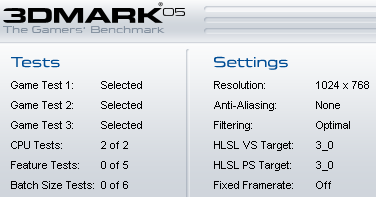
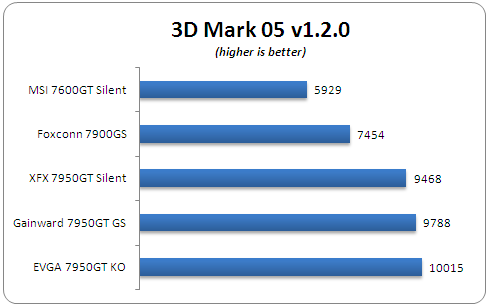
3D Mark 05 is a well known benchmark utility that represents the combination of CPU+VGA strength. The EVGA 7950GT KO is the only 7950GT card that breaks the 10.000 points barrier in the 3D Mark 05 benchmark. The Gainward 7950GT GS comes second, behind by 230 points, while the XFX 7950GT is 547 points back.
- 3D Mark 06 v1.0.2
 3DMark®06 is the worldwide standard in advanced 3D game performance benchmarking and the latest version in the popular 3DMark series! 3DMark06 tests include all new HDR/SM3.0 graphics tests, advanced SM2.0 graphics tests, AI and physics driven single and multiple cores or processor CPU tests and a collection of comprehensive feature tests to reliably measure next generation gaming performance today. Futuremark's exclusive Online ResultBrowser web service tracks and compares 3DMark06 scores. Again we left all settings as default:
3DMark®06 is the worldwide standard in advanced 3D game performance benchmarking and the latest version in the popular 3DMark series! 3DMark06 tests include all new HDR/SM3.0 graphics tests, advanced SM2.0 graphics tests, AI and physics driven single and multiple cores or processor CPU tests and a collection of comprehensive feature tests to reliably measure next generation gaming performance today. Futuremark's exclusive Online ResultBrowser web service tracks and compares 3DMark06 scores. Again we left all settings as default:


In 3D Mark 06, we see a similar picture to 3DMARK05. Again, the EVGA 7950GT KO provides the best performance with 5504 points, the Gainward 7950GT Golden Sample is close behind at 5388 points, while the XFC 7950GT Silent manages 5193 points.
7. F.E.A.R
 The story begins as an unidentified paramilitary force infiltrates a multi-billion dollar aerospace compound. The government responds by sending in Special Forces, but loses contact as an eerie signal interrupts radio communications. When the interference subsides moments later, the team has been literally torn apart. As part of a classified strike team created to deal with threats no one else can handle, your mission is simple: Eliminate the intruders at any cost. Determine the origin of the signal. And contain this crisis before it spirals out of control.
The story begins as an unidentified paramilitary force infiltrates a multi-billion dollar aerospace compound. The government responds by sending in Special Forces, but loses contact as an eerie signal interrupts radio communications. When the interference subsides moments later, the team has been literally torn apart. As part of a classified strike team created to deal with threats no one else can handle, your mission is simple: Eliminate the intruders at any cost. Determine the origin of the signal. And contain this crisis before it spirals out of control.
For all tests, we used the latest available patch that updates game engine to v1.08. The game offers 1280x1024 resolution, which was used for all tests. We maxed all details for CPU and for VGA card, except for Soft Shadows and AA/AF. We used Nvidia's 3D Control panel to enable AA/AF, as indicated in each graph.
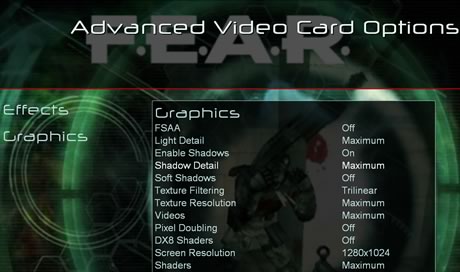
Below are the results after using the built-in benchmark test:
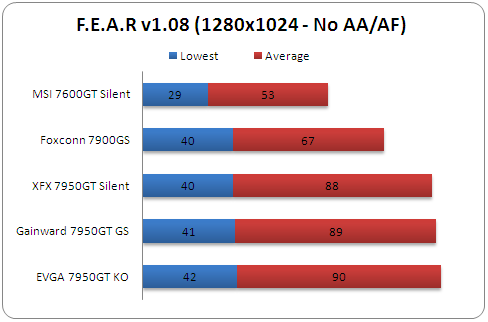
The difference in framerates between the three cards is minimal. The EVGA 7950GT managed the highest at 90FPS on average, while Gainward 7950GT and XFX 7950GT managed 89 and 88 FPS respectively. It would be interesting to see which card would be least affected after enabling AA/AF. That is the aim of our next test.

As was expected, enabling AA/AF creates a performance hit on all our tested cards. Both the EVGA 7950GT and Gainward 7950GT are very close, while the XFX 7950GT is the slowest of the three, since it has the lower core/memory clocks.
8. Prey
 Prey tells the story of Tommy, a Cherokee garage mechanic stuck on a reservation going nowhere. His life changes when an other-worldly crisis forces him to awaken spiritual powers from his long-forgotten birthright. Abducted along with his people to a menacing mothership orbiting Earth, he sets out to save himself and his girlfriend and eventually his planet.
Prey tells the story of Tommy, a Cherokee garage mechanic stuck on a reservation going nowhere. His life changes when an other-worldly crisis forces him to awaken spiritual powers from his long-forgotten birthright. Abducted along with his people to a menacing mothership orbiting Earth, he sets out to save himself and his girlfriend and eventually his planet.
Prey is a serious, dark story, based on authentic Cherokee mythology. Themes of sacrifice, love and responsibility are explored and the story dives into emotional territory not yet explored by similar games. Prey is based on Quake 3 engine and for sure will keep you awake many nights...
We used the latest available patch that updated the game engine to v1.2.0. For all tests we used hocbench that offers all benchmarking options through a GUI. We used the built-in Guru3D timedemo and all results are posted below:

Without enabling AA/AF, the EVGA 7950GT KO gets the first place with 93FPS, the Gainward 7950GT GS is next with 91FPS and the XFX 7950 Silent last of the three with 88FPS.

Enabling the various AA/AF rendering modes, we get very good performance from all three cards.
9. Splinter Cell Chaos Theory
 A Japanese Information Defense Force is formed to help face modern threats. Deemed a violation of international law and of the Japanese Post-War Constitution, Korea and China become outraged.
A Japanese Information Defense Force is formed to help face modern threats. Deemed a violation of international law and of the Japanese Post-War Constitution, Korea and China become outraged.
Secretly, the head of the IDF begins launching information-warfare attacks against Japan and blaming the attacks on North Korea. When the U.S. intervenes, as they are obligated to under Article 9 of the Japanese Post-War Constitution, the U.S. is attacked as well, forcing North Korea to escalate the situation with a pre-emptive invasion of South Korea. As war erupts on the Korean Peninsula, Sam Fisher must thwart the alliance between the Japanese Admiral, a neurotic computer hacker, and the head of an international paramilitary company in order to prevent the rekindling of a massive world war in the Pacific.

The graphics engine supports Pixel Shader 1 and 3, HDR, along with other new effects. We used hocbench that offers all benchmarking options through an easy GUI. We used the built-in "Guru3D 2" timedemo and all results are posted below, using SM1.1
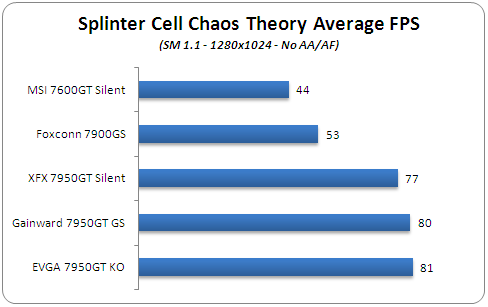
It's very much the same scenario we've seen up till now with the EVGA 7950GT leading and the other two cards close behind.
Splinter Cell - Chaos Theory also supports Shader Model 3.0 that can be enabled easily within hocbench software:
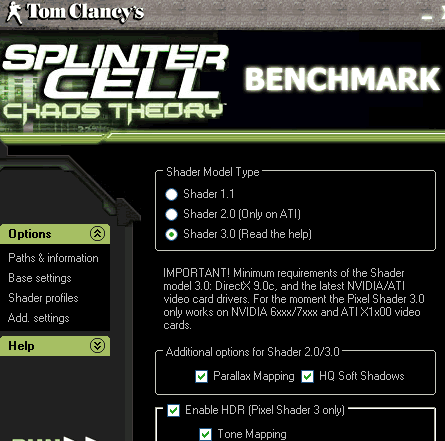
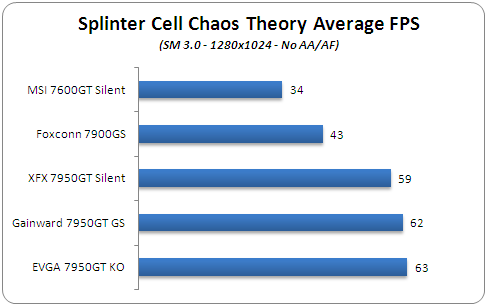
SM3.0 offers much better visual details but at a cost in performance. Again, the EVGA is out in front with 63FPS.
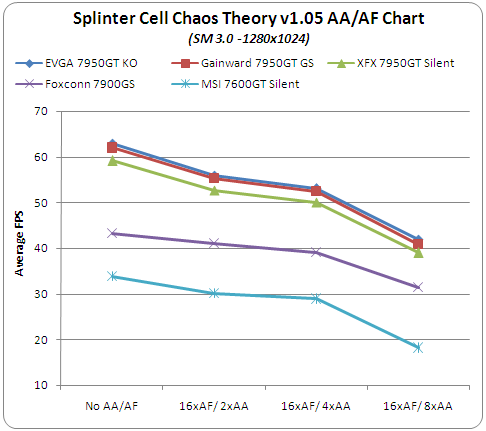
Enabling AA/AF drops the performance even further for all cards. With maximum visual quality, all 7950GT cards are at over or close to in the case of the XFX card, 40FPS, making the game very playable.
10. Half Life 2 Episode 1
The world of Half-Life 2 has amazed everyone with its great story, graphics and Valve's great support. Half-Life 2: Episode One is the first in a series of new adventures created by Valve that extend the Half-Life 2 single player experience. It details the aftermath of Half Life 2 and launches a journey beyond City 17.
 Stepping into the hazard suit of Dr. Gordon Freeman, you face the immediate repercussions of your actions in City 17 and the Citadel. Rejoin Alyx Vance and her robot, Dog, to once again aid the human resistance in their desperate battle against the totalitarian alien menace of the Combine.
Stepping into the hazard suit of Dr. Gordon Freeman, you face the immediate repercussions of your actions in City 17 and the Citadel. Rejoin Alyx Vance and her robot, Dog, to once again aid the human resistance in their desperate battle against the totalitarian alien menace of the Combine.
Episode One exposes Alyx's combat skills and knowledge of City 17. Battle side-by-side with her through Valve's first episodic game, a four-to-six hour adventure of greater density and detail than non-episodic releases.
We recorded a timedemo and used the built-in console to run the timedemo for each card. All tests were done at 1280x1024 with HDR shadows fully enabled. Antialiasing and Filtering modes were enabled through Nvidia's 3D control panel:
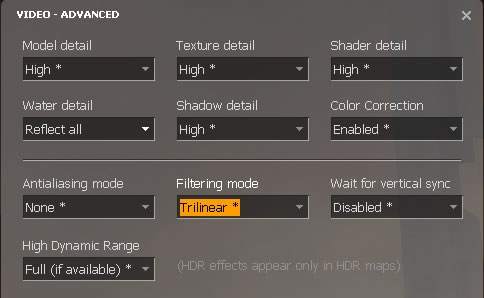

At 1280x1024, both the EVGA 7950GT KO and Gainward 7950GT GS managed over 120FPS each, while the XFX 7950GT was somewhat slower at 116FPS.
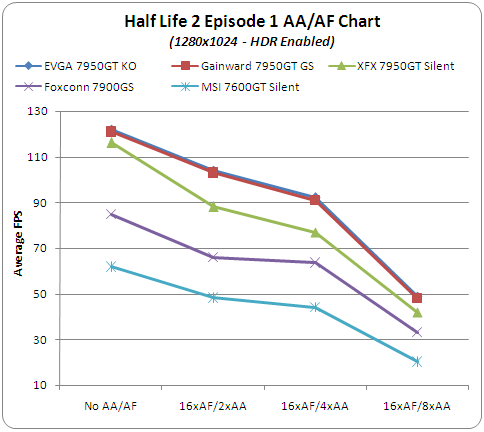
HDR Effects and AA/AF do have an impact on performance. With the highest possible visual quality settings, the EVGA 7950GT KO and Gainward 7950GT keep close to 50FPS. The XFX 7950GT is somewhat slower.
11. Company Of Heroes
 In Company of Heroes, gamers will experience the journey of the brave men of Able Company in a deep single-player campaign that begins with the invasion of Normandy through their fight across Europe, all set against the most dynamic battlefield ever seen in a game.
In Company of Heroes, gamers will experience the journey of the brave men of Able Company in a deep single-player campaign that begins with the invasion of Normandy through their fight across Europe, all set against the most dynamic battlefield ever seen in a game.
Company of Heroes' completely destructible environment means no two battles ever play out in the same way. Advanced squad AI delivers startling new realism and responsiveness, bringing soldiers to life as they interact with the environment and execute advanced squad tactics to eliminate the opposition forces.

The game offers impressive graphics, especially when all visual and quality settings are set to the maximum.
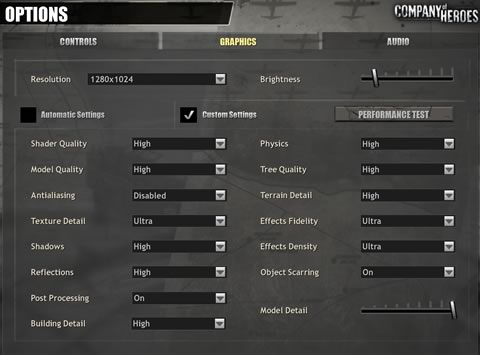
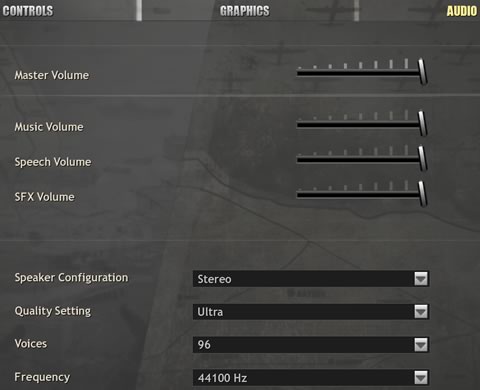
We used the built-in benchmark for all tests at 1280x1024 resolution. Since AA/AF cannot be set from within the game, we used Nvidia's 3D control panel for each mode. The built-in Antialiasing setting in Company Of Heroes has been disabled. After having seen all possible settings, let's see how each card performed in the Company Of Heroes Benchmark with High Quality settings.

The EVGA 7950GT KO continues to hold first place with 66FPS. All three 7950GT cards provide very similar performance.

Company Of Heroes doesn't seem to impact heavily when the AA/AF rendering modes are enabled. With the best quality mode, the 7950GT cards managed framerates close to or above 50FPS.
12. BattleField 2142
 The year is 2142, and the dawn of a new Ice age has thrown the world into a panic. The math is simple and brutal: The soil not covered by ice can only feed a fraction of the Earth's population. Some will live, most will die. In Battlefield 2142, players will choose to fight for one of two military superpowers in an epic battle for survival, the European Union or the newly formed Pan Asian Coalition.
The year is 2142, and the dawn of a new Ice age has thrown the world into a panic. The math is simple and brutal: The soil not covered by ice can only feed a fraction of the Earth's population. Some will live, most will die. In Battlefield 2142, players will choose to fight for one of two military superpowers in an epic battle for survival, the European Union or the newly formed Pan Asian Coalition.
Armed with a devastating arsenal of hi-tech assault rifles, cloaking devices and sentry guns, players will also do battle using some of the most imposing vehicles known to man. Massive battle Mechs wage fierce combat on the ground, while futuristic aircraft rule the skies. When facing one of these new behemoths, players will need to use their wits and an arsenal of new countermeasures like EMP grenades to level the playing field.
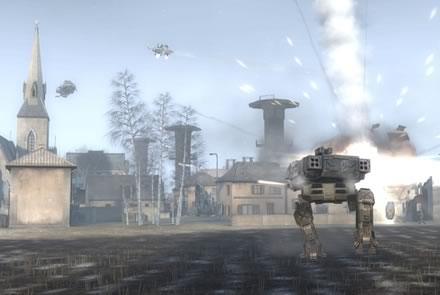
Team play features allow up to 64 players to enter the action on the front lines as part of a formal squad, or work behind the scenes in Commander Mode to direct the strategic assaults of their teammates. With in-game success, players increase their rank and unlock awards, including new weapons, medals and more, delivering the most comprehensive and flexible persistence in the Battlefield universe to date.
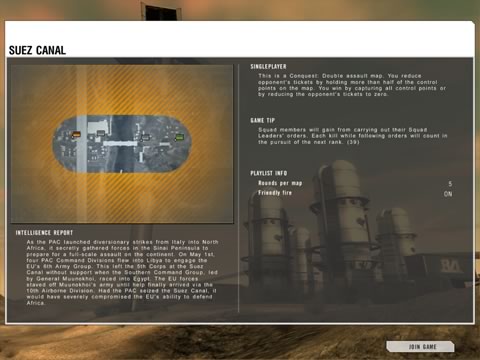
In order to benchmark the graphics cards, we recorded our own timedemo using the built-in command (demo.recordDemo). We then used the Guru3D BF2 benchmark, modified in order to support BF 2142. We used the following quality settings. Anti-aliasing is disabled inside the game, and we use Nvidia's 3D Control Panel to enable/disable AA/AF rendering modes:
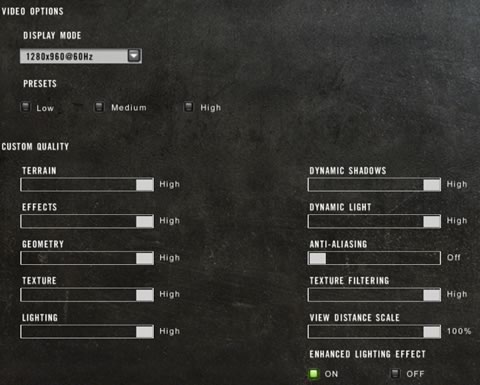
Note that the 1280x1024 resolution is not supported in the game. However, it can be enabled from the command line. All tests were performed at that resolution (1280x1024). Since the game counts all frames, including loading screens, we removed them so that all numbers represent pure gaming experience. Note that all tests are performed at 1280x1024 with the default camera view. Let's now proceed to the first test results.

At 1280x1024, the EVGA 7950GT KO was the fastest card with 88FPS.

Enabling AA/AF in Battlefield 2142 enhances visual quality and of course gaming experience. The most appropriate mode for all three 7950GT cards is with 16xAF and 4x AA, since all cards were above 50FPS (average). With 8x AA, performance drops down to 30FPS.
13. NFS Carbon
 Need for Speed Carbon delivers the next generation of adrenaline-filled street racing and will challenge players to face the ultimate test of driving skill on treacherous canyon roads.
Need for Speed Carbon delivers the next generation of adrenaline-filled street racing and will challenge players to face the ultimate test of driving skill on treacherous canyon roads.
What starts in the city is settled in the canyons as Need for Speed Carbon immerses you into the world's most dangerous and adrenaline-filled form of street racing. You and your crew must race in an all-out war for the city, risking everything to take over your rivals' neighbourhoods one block at a time. As the police turn up the heat, the battle ultimately shifts to Carbon Canyon, where territories and reputations can be lost on every perilous curve.

Lets race...
Need for Speed Carbon delivers the next generation of customization giving you the power to design and tweak your crew's cars in every way using the ground-breaking new Autosculpt technology. Represent your car class, your crew, and your turf in Need for Speed Carbon, the next revolution in racing games.
In order to benchmark the graphics cards, we created the same two rounds at the same track with the same car. By using FRAPS, we recorded all 2 minutes of driving.
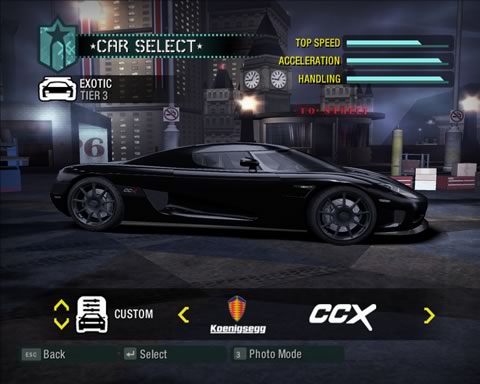
Black and beautiful...
Keep in mind that all tests results were done with "Blur Effect" and "Rain" disabled, since enabling them gives a huge performance hit on all cards. In any case, all other detail settings are maxed out. As usual, AA/AF modes are set by using Nvidia's 3D control panel.
Without enabling AA/AF, we can see the performance of each card at 1280x1024.

The EVGA 7950GT KO had the highest performance with 41FPS average and 31 FPS lowest frame rate. The Gainward 7950GT GS continues to be behind by only 1 FPS as has been the case with almost every benchmark to date.
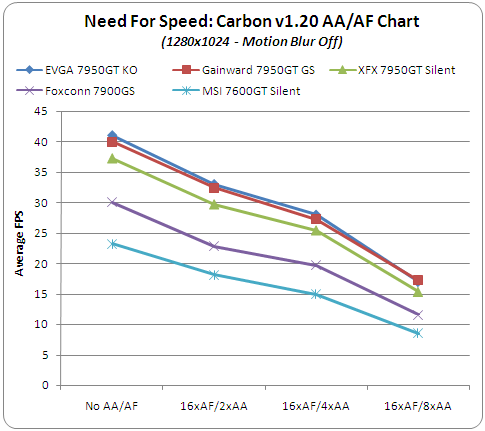
Enabling AA/AF in NFS Carbon is...difficult for all VGA cards to handle. We assume that an acceptable frame rate would be something above 25~30FPS, so stay with 16xAF/2xAA, even with your newly bought 7950GT card. Adding a second 7950 (SLI) will probably boost NFS Carbon's overall performance.
14. NeverWinter Nights 2
 Bards sing tales of heroes from ages past, but never have the Forgotten Realms so desperately needed a champion. Years have passed since the war between Luskan and Neverwinter, almost enough time for the wounds of war to heal. But the brief peace the Realms have known may be at an end. Tension growing between the mighty city-states means the Sword Coast again teeters on the edge of open war.
Bards sing tales of heroes from ages past, but never have the Forgotten Realms so desperately needed a champion. Years have passed since the war between Luskan and Neverwinter, almost enough time for the wounds of war to heal. But the brief peace the Realms have known may be at an end. Tension growing between the mighty city-states means the Sword Coast again teeters on the edge of open war.
Unnoticed, a greater danger stalks the City of Skilled Hands. Unbeknownst to the denizens of the North, deep in the Mere of Dead Men, dark forces from across the Realms have been rallied under the banner of a legendary evil. If left unchallenged, all of the North is doomed to fall under its power.
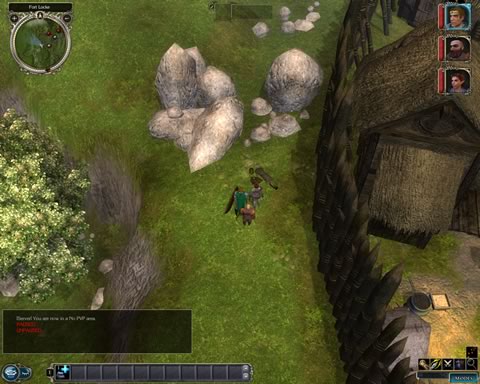
Even in this darkest hour, hope remains. A mysterious relic is borne to Neverwinter in the hands of a lone hero so that its secrets may be unlocked - secrets that carry the fate of all the North. So begins an epic tale of shattered alliances, noble acts and dark deeds to be told across the Realms for generations to come.
Under Game options, we maxed all available visual settings.

Anisotropic filtering was enabled in the "Advanced Graphics" tab, while Anti-aliasing modes were set by using Nvidia's 3D control panel.
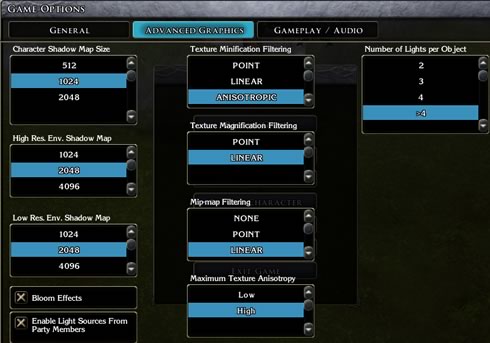
We saved a game and then ran/walked the exact same route (more or less) and moved the camera a lot around the player. This is the worst case scenario while playing. Using FRAPS, we recorded two minutes of game and got the lowest and average numbers.

NeverWinter Nights2 is a "difficult" game, with all visual improvements enabled, even for the EVGA 7950GT KO. The card sustains an average of 34FPS. We can say that the game is mostly playable above 25FPS, so no worry here for all the 7950GT cards.

Antialiasing is not available from within the game's options. Using Nvidia's 3D control panel, we enabled up to 8x AA. Both the EVGA and Gainward 7950GT cards performed the similarly, but the XFX 7950GT was somewhat slower. The Foxconn 7900GS takes a huge performance hit when switching from 2x to 4x AA.
15. Overclocking
There is always a way to improve the performance of your system by overclocking it. All three cards are overclocked, compared with Nvidia's 7950GT reference board. No doubt, it would be even better if we could manage to overclock them even more. Using coolbits registry "hack", we enabled the overclocking features in Nvidia's control panel. Next step was to do our usual trial and error process, raising the frequency, running 3D Mark06 to stress test the VGA card and seeing if the system was stable or not. Our best trials are shown below, with the stock clock frequencies included for comparison:
VGA Card |
Core |
Memory |
Stock |
OC |
% difference |
Stock |
OC |
% difference |
EVGA 7950GT KO |
600 |
663 |
10.50 |
725 |
864 |
19.17 |
Gainward 7950GT GS |
580 |
664 |
14.48 |
750 |
875 |
16.67 |
XFX 7950GT Silent |
550 |
632 |
14.91 |
700 |
804 |
14.86 |
The most overclockable card was the Gainward 7950GT, due to its very good cooling system and the different memory modules used. The EVGA 7950GT has good memory OC, while the XFX 7950GT Silent was the "lowest" performer in this test although it did provide the best relative increase in Core speed. Don't forget, that the XFX 7950GT has passive cooling that reduces overclocking potential. After setting the highest possible clocks, we ran a few tests to see if performance improves at all.

The 3D Mark05 overall score is greatly affected by overclocking. The EVGA 7950GT KO easily breaks the 11.000 points barrier, while, surprisingly, the XFX 7950GT shoots into second place with 10432. The Gainward 7950GT GS doesn't seem to increase its performance by all that much. In 3D Mark 06, we see exactly the same behaviour...

Passing on to real life gaming, the EVGA 7950GT and Gainward 7950GT are neck and neck, but the Gainward 7950GT GS had much better performance under Splinter Cell Chaos theory.



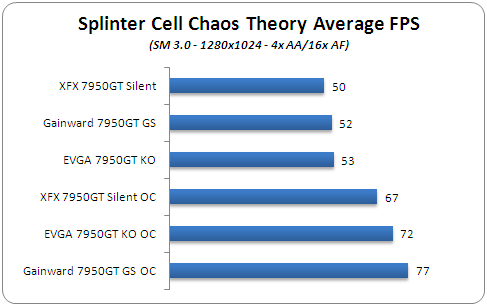
Concluding, we were hoping to see much better performance from the Gainward 7950GT, since it had the highest clocking frequencies for both memory and core. However, the performance increase was not as impressive as with the EVGA 7950GT KO or even the XFX 7950GT Silent. The only explanation we can give, is that the Gainward 7950GT uses Samsung memory modules, while both the EVGA and XFX 7950GT use Infineon memory modules.
16. Temperature
All three 7950GT cards have different cooling systems, that affect overclocking and the temperature of the G71GT core. Below, we provide a graph of the temperature, as reported by Everest Ultimate Edition 2006.
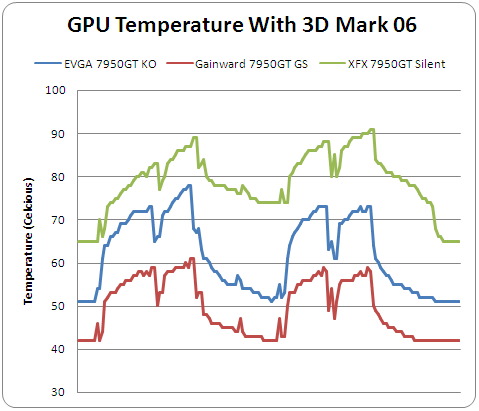
Gainward's cooling system is highly effective. Just look at the red line in the graph above. Looks very good. On the other hand, the eVGA 7950GT KO air cooling system, also does a good job but nowhere near as good as Gainward's. Lastly, XFX's 79500GT passive cooling system is the least effective, reaching 91°C at full load.

For those who prefer straight numbers, in the graph above, Gainward 7950GT ran at 50°C average, the eVGA 7950GT KO at 62°C and the XFX 7950GT Silent at 79°C. Things get pretty hot with the XFX card at 91°C maximum.
17. Conclusion
.jpg) Before writing this roundup, I was very curious as to how three 7950GT cards would perform, with different core/memory clocks and features. According to Nvidia "...GeForce 7950 GPU delivers smooth, high-definition video playback and crisp picture quality thanks to its advanced NVIDIA PureVideo technology. If you are searching for an extreme HD gaming and video experience on the PC, look no further than a Geforce 7950 GPU..."
Before writing this roundup, I was very curious as to how three 7950GT cards would perform, with different core/memory clocks and features. According to Nvidia "...GeForce 7950 GPU delivers smooth, high-definition video playback and crisp picture quality thanks to its advanced NVIDIA PureVideo technology. If you are searching for an extreme HD gaming and video experience on the PC, look no further than a Geforce 7950 GPU..."

For an easy comparison, we gathered the most important features for the three cards in one table:
VGA Card |
Core |
Memory |
Price (€) |
Retail package |
Special features |
eVGA 7950GT KO |
600MHz |
725MHz |
290~310 |
Call Of Duty 2 |
Copper heatsink covers memory modules, limited lifetime warranty |
Gainward 7950GT 512MB Golden Sample |
580MHz |
750MHz |
285~320 |
Muvee AutoProducer, option to download free games from Gainward |
Impressive air cooling design, needs two slots at back port |
XFX GeForce 7950GT 550M |
550MHz |
750MHz |
270~300€ |
Ghost Recon Advanced Warfighter, printed users manual in 13 languages |
Passive cooling - zero noise |
Before proceeding to the differences, lets see what's inside the retail package for each card: 2x DVI-D dongles, TV-Out cables, 6 pin PCI-E cable, CD-ROM with drivers and a printed manual. All three cards provide dual DVI outputs with HDCP support and are rated "Vista Ready", according to their respective manufacturers. Let's now see each card's strong points:
eVGA 7950GT KO: This card was the top performer in all tests, since it had the highest core frequency. The eVGA has bulked the retail version of "Call Of Duty 2", that will please gamers. The air cooling system is adequate and the card generated temperatures ranging from 51°C up to 78°C maximum! At full speed, the fan is the noisiest of all three cards. The card didn't have any problems overclocking or competing with the Gainward 7950GT Golden Sample in this department.

| Performance |
 |
| Overclocking |
 |
| Bundle |
 |
| Value for money |
 |
Gainward 7950GT 512MB Golden Sample: The second fastest card, by one FPS in most tests in this roundup. The main reason was the lower core frequency and possibly different memory modules (Samsung as opposed to eVGA's Infineon). There is no retail game included, but there is a #SN that can be used to download games from Gainward's servers. The air cooling system is impressive, but large. It makes little noise(!) and keeps the G71GT core cool. Imagine that under full load, the temperature never passed above 61°C. Due to its size, it will occupy two backplane slots, which is not a big deal unless you have few PCI slots or a lot of PCI cards installed since several motherboard have them positioned between the PCI-E slots. Overall, a good proposal and somewhat lower priced than the eVGA 7950GT KO.

| Performance |
 |
| Overclocking |
 |
| Bundle |
 |
| Value for money |
 |
XFX GeForce 7950GT 550M: The less "powerful" card in this roundup, with however, different characteristics. Its passive cooling system produces zero noise and keeps the card running. However, things get really hot, especially if you consider that at full load, the GPU reached 91°C! But if you think that overclocking is not possible with this card, think again. We managed to reach a stable system with 632/804 frequencies and performance was greatly improved. We suspect that if the card had an active cooling system, it could possibly match the performance of the eVGA's 7950GT KO. Users who love Ghost Recon can find the retail version of "Ghost Recon Advanced Warfighter" bulked with this card. Something we also noticed was the 13 language printed manual, useful for non-english speaking users. Lastly, it has the lowest price in this roundup, with a retail price of €270~300.

| Performance |
 |
| Overclocking |
 |
| Bundle |
 |
| Value for money |
 |